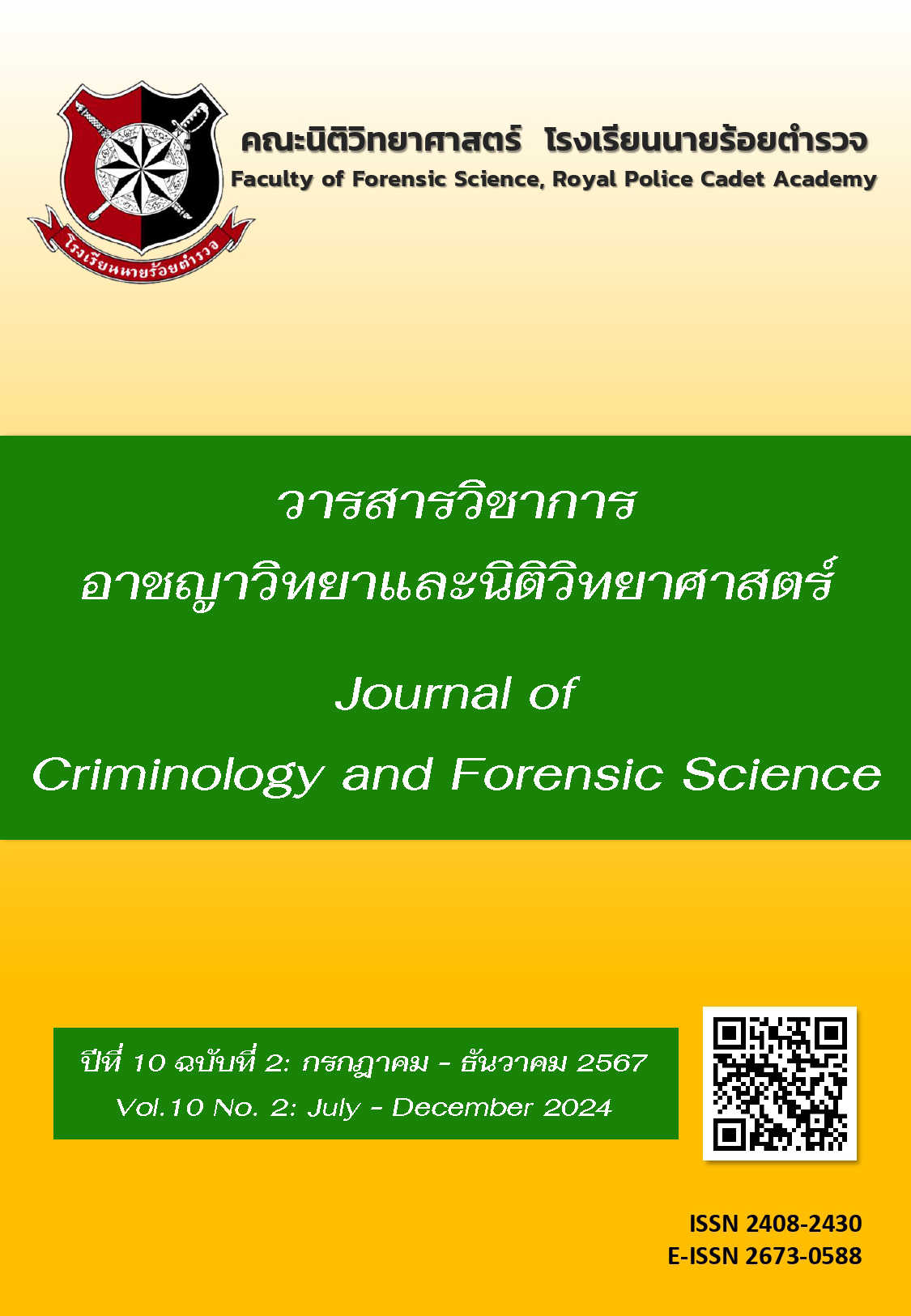Development Guidelines for the Protection of Forensic Evidence by Emergency Medical Responders in Bangkok
Main Article Content
Abstract
In emergency situations, collecting and preserving evidence from sudden incidents, including those involving injuries and fatalities, requires attention to forensic evidence protection as a critical priority. Emergency medical responder are often the first responders at the scene, providing assistance while simultaneously safeguarding evidence, a necessary aspect of the justice process. This research examines the knowledge level and opinions of emergency medical responder in Bangkok, analyzing the correlation between background factors and both knowledge and opinion levels. The aim is to propose strategies for enhancing emergency medical practices alongside forensic evidence protection. The study employed a mixed-methods approach, gathering data through questionnaires from 136 emergency medical response and conducting in-depth interviews with 15 experienced team leaders and officers. The findings revealed that educational level correlates with knowledge and opinions. The participants displayed a high level of knowledge regarding forensic evidence preservation, with 79.41% indicating strong familiarity. However, there remains a gap in practical understanding, as shown by the high mean scores for the desire to receive training (4.76) and the inclusion of forensic content in training programs (4.77). Content analysis suggested that forensic evidence protection improvement can be achieved by focusing on practical training to develop operational skills, creating comprehensive operational guidelines covering emergency medical responder roles in various situations, as well as updating legal frameworks and adding policies for integration with relevant agencies in a tangible manner.
Article Details

This work is licensed under a Creative Commons Attribution-NonCommercial-NoDerivatives 4.0 International License.
เนื้อหาและข้อมูลในบทความที่ลงตีพิมพ์ใน วารสารวิชาการอาชญาวิทยาและนิติวิทยาศาสตร์ โรงเรียนนายร้อยตำรวจ ถิอว่าเป็นข้อคิดเห็นและความรั้บผิดชอบของผู้เขียนบทความโดยตรงซึ่งกองบรรณาธิการวารสาร ไม่จำเป็นต้องเห็นด้วยหรือรับผิดชอบใดๆ
บทความ ข้อมูล เนื้อหา รูปภาพ ฯลฯ ที่ได้รับการตีพิมพ์ใน วารสารวิชาการอาชญาวิทยาและนิติวิทยาศาสตร์ ถือว่าเป็นลิขสิทธิ์ของวารสาร วารสารวิชาการอาชญาวิทยาและนิติวิทยาศาสตร์ หากบุคคลหรือหน่วยงานใดต้องการนำทั้งหมดหรือส่วนหนึ่งส่วนใดไปเผยแพร่ต่อหรือเพื่อกระทำการใดๆ จะต้องได้รับอนุญาตเป็นลายลักษณ์อักษรจาก วารสารวิชาการอาชญาวิทยาและนิติวิทยาศาสตร์ ก่อนเท่านั้น
References
Bangkok Emergency Medical Service Center (Erawan Center), Medical Department, Bangkok Metropolitan Administration. (2023). Statistics on emergency medical services [Unpublished document].
Bloom, B. S. (1956). Taxonomy of educational objectives: The classification of educational goals. United States of America: David McKay Company.
Emergency Medical Committee. (2019). Announcement of the types, levels, powers, duties, responsibilities, and limitations of emergency operations units, B.E. 2562 (Vol. 136, Special Issue 58 Ng, pp. 2-11). Government Gazette.
Emergency Medical Committee. (2020). Regulation on defining practitioners, organization accreditation, and training programs, and issuing certificates or insignia for graduates, B.E. 2563 (Vol. 137, Special Issue 96 Ng, p. 20). Government Gazette.
Emergency Medical Committee. (2022). Standards for Emergency Medical Qualifications (MEC 1), B.E. 2565 (Vol. 139, Special Issue 106 Ng, pp. 5-6). Government Gazette.
Emergency Medical Committee. (2023). Announcement on types, levels, powers, duties, responsibilities, or limitations of practitioners in emergency operations under medical orders or direction, B.E. 2566 (Vol. 140, Special Issue 165 Ng, pp. 43-44). Government Gazette.
Engsombun, S. (2008). Preliminary crime scene investigation. Nakhon Pathom: Royal Police Cadet Academy.
Huabbangyang, T., & Kulnides, N. (2021). Study of the problems and obstacles in forensic evidence preservation and crime scene management among Thai emergency medical practitioners. The 9th Suan Sunandha National Academic Conference. Suan Sunandha Rajabhat University.
Kerdvichai, N. (2003). Civil and criminal procedure code. Nakhon Pathom: Nitnai.
Laoleerat, T. (1987). Human resource development in public sector personnel management. Bangkok: Victory Powerpoint.
Ministry of Public Health. (2020). Evidence management manual (1st ed.). Bangkok.
National Institute for Emergency Medicine. (2014). Emergency medical system of local government organizations. Nonthaburi: National Institute for Emergency Medicine.
National Statistical Office. (2023). Statistics on criminal cases involving life, body, and sexual offenses categorized by type of offense by province, 2017 – 2023. Retrieved from http://statbbi.nso.go.th/staticreport/page/sector/th/09.aspx.
Royal Institute. (2013). Dictionary of the Royal Institute, B.E. 2554 (1st ed.). Bangkok: Royal Institute.
Saenkaewkas, S. (2021). Knowledge and understanding of crime scene preservation and forensic evidence among emergency medical service personnel in Nonthaburi
Province. Journal of Criminology and Forensic Science, Royal Police Cadet Academy, 7(1), 1-14.
Suwanchasri, P. (2015). Understanding of forensic and medical evidence by professional nurses in the emergency department of Phramongkutklao Hospital (Master’s thesis). Silpakorn University, Nakhon Pathom.
Tongtawee, J. (2018). Understanding and opinions of Pitakkarn Foundation rescue officers on protection and preservation of physical evidence at crime scenes (Master’s thesis). Silpakorn University, Nakhon Pathom.
Utta, T. (2012). The study of the process of preserving crime scenes and forensic evidence by foundation personnel in Chonburi Province (Master’s thesis). Silpakorn University, Nakhon Pathom.

